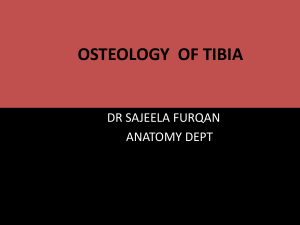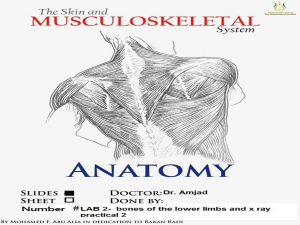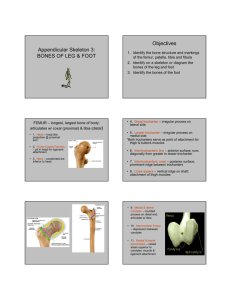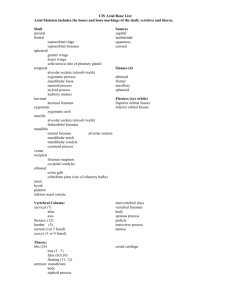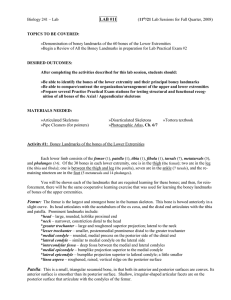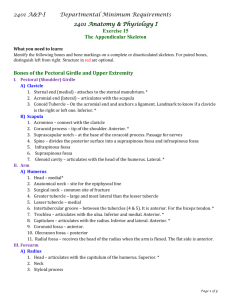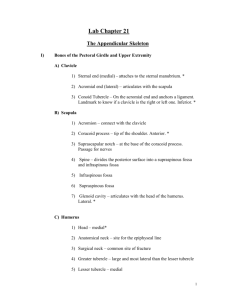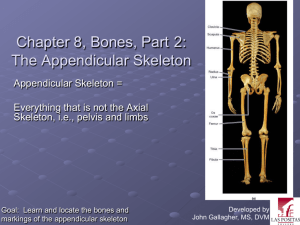Bones of the Lower Extremity
advertisement
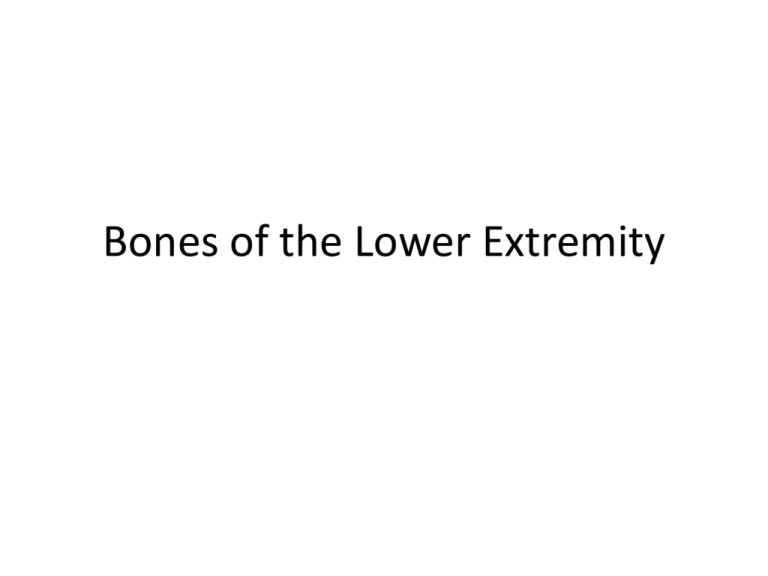
Bones of the Lower Extremity Bones of the Pelvic Girdle • The pelvic (or hip) girdle: – Attaches the lower limbs to the axial skeleton – Transmits the weight of the upper body to the lower limbs – Supports the visceral organs of the pelvis – Some of the strongest ligaments of the body support the pelvic girdle – Formed by a pair of “hip” bones called coxal bones, and the sacrum Each os coxae has an: • Illium: The large upper portion, often called your “hip bone”. • Ishium: The posterior/inferior bone, often called your “seat bone”. • Pubis: The anterior/inferior bone, which connects in front at the pubic symphysis. • Acetabulum: point of fusion of all three, also called your “hip socket”. Landmarks for the Ilium • Iliac crest: the thick, upper margin • Iliac fossa: anterior smooth surface • Anterior superior/ Anterior inferior Iliac spine: sites for muscle attachments • Posterior superior/ Posterior inferior Iliac spine: sites for muscle attachments • Greater sciatic notch • Auricular surface Landmarks for the Ishium: • Ishial tuberosity: site for attachment of hamstring muscles • Ishial spine: site for ligament attachment, measurement site for pelvic opening. • Obturator foramen: the only “hole” or opening for nerves/blood vessels. • Ishial ramus: point of connection with inferior ramus of pubis. Landmarks for the pubis: • Superior/inferior ramus • Pubic crest and tubercle: site of attachment for abdominal muscles • Pubic symphysis: articulation point that connects the two pubic bones together • Pubic arch: helps to determine male vs. female pelvis Bones of the Lower Limb • Femur: – Single bone of the thigh; is the largest, longest, and strongest bone in the body. – The femur cannot be palpated (felt) because it is covered by large muscles. – The head of the femur articulates with the acetabulum of the os coxae, and has a small, pit shaped depression called the fovea capitis, which is where the ligamentum teres helps to secure the head into the acetabulum. Landmarks of the femur: • • • • Head; fovea capitis Neck: often a site for fracture Greater and lesser trochanter: attachment site for muscles Intertrochanteric line and crest: line is anterior, crest is posterior • Linea aspera: “rough line” on the posterior aspect of shaft • Medial and lateral condyle: articulation with the tibia • Medial and lateral epicondyle: only part of the femur that can be felt at the knee • Intercondylar fossa or notch: cruciate ligaments attach here. • Patellar surface: the smooth surface above the condyles on the anterior side that articulates with the patella • Popliteal surface: surface above the condyles on the posterior side Patella • The patella is a triangular shaped sesamoid bone encased in the patellar tendon. • The patellar tendon attaches the quadriceps femoris muscle to the tibia. • It has two surfaces; the rounded, convex anterior surface, and the smooth, articular posterior surface. Tibia • The bone on the medial side of the lower leg…it is the weight-bearing bone of the lower leg. (“Tough Tibia”) • Landmarks of proximal tibia (upper portion) – Medial and lateral condyle • Articulates with the medial and lateral condyle of the femur. – Intercondylar emminence: • The ridge of bone that projects upwards between the condyles. It is the attachment site for the cruciate ligaments, medial meniscus, and lateral meniscus – Fibular facet: • Just below the lateral condyle where the head of the fibula articulates. Tibia • Other Landmarks: – Tibial tuberosity: • roughened protuberance on the anterior surface just below the condyles. Is the attachment site of the patellar ligament. – Anterior crest • On the anterior surface of the body. Can palpate the entire length, also called your “shin”. – Medial malleolus • Large bony prominence on the medial side of your ankle – Fibular notch • Distal end of tibia, where it articulates with the distal end of the fibula Fibula • The slender bone on the lateral side of the lower leg. “Fine Fibula”. • Landmarks: – Head: • The enlarged proximal end, articulating with the fibular facet of the tibia – Shaft or body: • Long slender portion – Lateral malleolus: • Large prominence on the lateral, distal end. Articulates with the lateral surface of the talus. – Malleolar fossa • Small fossa on the distal end opposite lateral malleolus Bones of the Foot • Bones of the ankle are TARSALS • Bone of the “ball” of your foot are called METATARSALS… In-between the tarsals and your toes (phanges). • Bones of your toes are called Phalanges (plural). A singular bone is called a phalanx.
